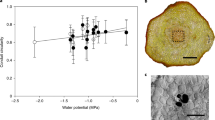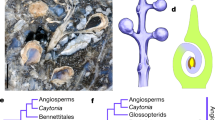Abstract
A STRIKING feature of botany as the science XJL exists at prej ift is the lack of any coherent body of comp£"n?ive morphological doctrine dealing with bd aimKspernis. There are no books on the ncmeftjp plants in any way comparable with Bower's wW the ferns or Chamberlain's on gymnosperms. Asia result, the treatment of angiosperms in university courses on botany is usually confined to separate and unrelated series of lectures on systematics and on plant anatomy. In seeking a remedy for this remarkable situation one cannot but be impressed by the almost complete neglect of the gross anatomy of the primary vascular system, or what the older anatomists called "the course of the vascular bundles in the stem". Analogy with the study of other groups suggests that this department of anatomy may be expected to yield data of phylogenetic significance. The pioneer paper published by Nageli1 in 1858 is still our principal source of information on this topic, the few memoirs which have appeared since that date being for the most part descriptions of the development of single species or accounts of the more obviously aberrant groups such as Piperacese. There have also been some publications dealing with the number of traces to a leaf in various families (for example, Sinnott2). The neglect of the subject may be attributed almost entirely to the fact that Nageli and nearly all subsequent writers have paid altogether too much attention to the supposed basipetal development of the leaf traces, and have described vascular systems in terms of traces running down the stem and joining on to the traces of older leaves. Descriptions framed in this way make very tedious reading, and are so ill-adapted to the comparison of related vascular systems as to be' almost unintelligible without the aid of diagrams. Furthermore, such accounts tend to emphasize relatively trivial features, especially the numbers of internodes which the various bundles traverse, at the expense of others which are really far more important.
This is a preview of subscription content, access via your institution
Access options
Subscribe to this journal
Receive 51 print issues and online access
$199.00 per year
only $3.90 per issue
Buy this article
- Purchase on Springer Link
- Instant access to full article PDF
Prices may be subject to local taxes which are calculated during checkout
Similar content being viewed by others
References
Beitr. wiss. Bot., 1 (1858).
Amer. J. Bot., 1, 303 (1914).
Ann. Bot., N.S., 9, 141 (1945).
New Phytol., 45, 145 (1946).
Author information
Authors and Affiliations
Rights and permissions
About this article
Cite this article
DORMER, K. Anatomy of the Primary Vascular System in Dicotyledonous Plants. Nature 158, 737–739 (1946). https://doi.org/10.1038/158737a0
Issue Date:
DOI: https://doi.org/10.1038/158737a0
This article is cited by
-
Vascular connections of axillary buds in some members of the verbenaceae and the labiatae
Proceedings / Indian Academy of Sciences (1968)
-
Vascular patterns in dicotyledons
The Botanical Review (1963)
-
New Divisions of Vascular Plants
Nature (1947)
Comments
By submitting a comment you agree to abide by our Terms and Community Guidelines. If you find something abusive or that does not comply with our terms or guidelines please flag it as inappropriate.



